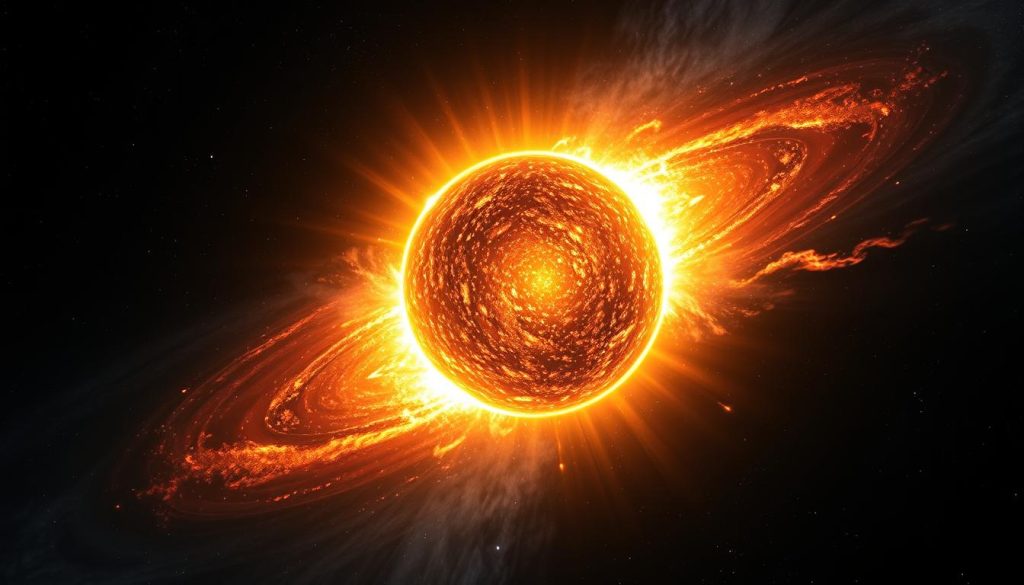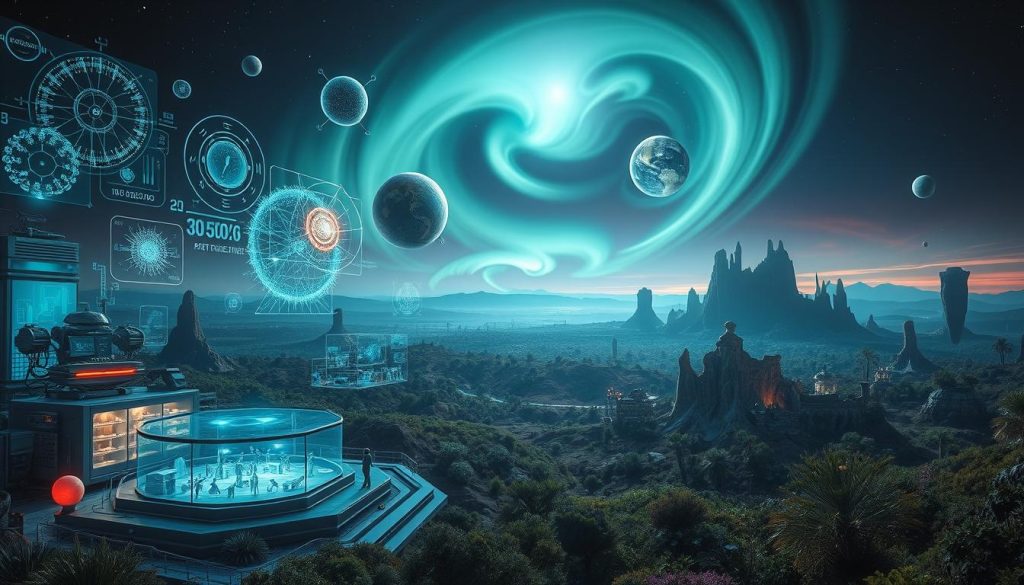
The world of crazy science facts is full of surprises. There are many unbelievable science facts that challenge our understanding of reality.
Thank you for reading this post, don't forget to subscribe!This article will share some science facts that seem fake but are true. It’s a journey through the fascinating and sometimes bizarre world of scientific truths.
These facts range from the strange to the astonishing. They are backed by evidence and will make you wonder about our world’s complexity.
Key Takeaways
- Discover the most astonishing scientific truths.
- Explore the fascinating world of crazy science facts.
- Understand the evidence behind unbelievable science facts.
- Learn about the science facts that seem too good (or fake) to be true.
- Uncover the truth behind seemingly bizarre scientific phenomena.
The Mind-Bending Reality of Scientific Discovery
Scientific discoveries often challenge our perceptions, revealing a reality that is both astonishing and counterintuitive. The natural world is full of mind-blowing science facts that, despite sounding unbelievable, are grounded in empirical evidence and rigorous research.
One of the fascinating aspects of scientific inquiry is how it often defies common sense. Science facts that sound fake but are actually true are not just intriguing anecdotes; they represent the cutting edge of human understanding and the relentless pursuit of knowledge.
When Scientific Truth Defies Common Sense
Many shocking science facts you won’t believe are verified through experiments and observations that push the boundaries of our understanding. For instance, certain phenomena in quantum mechanics seem to defy logic, yet they are supported by robust mathematical frameworks and empirical data.
The process of verifying seemingly impossible facts involves rigorous testing and validation. Scientists rely on evidence-based methods to confirm or refute hypotheses, ensuring that the conclusions drawn are reliable and reproducible.
How Researchers Verify Seemingly Impossible Facts
Researchers employ a variety of methods to verify science facts that sound fake but are actually true. This includes:
- Experimental verification: Conducting experiments to test hypotheses under controlled conditions.
- Observational evidence: Gathering data from observations, often using advanced technology.
- Peer review: Submitting findings for review by other experts to validate the methodology and conclusions.
The table below summarizes some of the key methods used in scientific verification:
| Method | Description | Example |
|---|---|---|
| Experimental Verification | Testing hypotheses under controlled conditions | Particle accelerator experiments |
| Observational Evidence | Gathering data from observations | Astronomical observations using telescopes |
| Peer Review | Validation by other experts | Reviewing scientific papers before publication |

In conclusion, the reality of scientific discovery is indeed mind-bending, filled with facts that challenge our understanding and broaden our knowledge. By embracing these mind-blowing science facts, we not only expand our comprehension of the world but also foster a deeper appreciation for the scientific process.
Fact #1: Water Can Boil and Freeze at the Same Time
At a specific pressure and temperature, water can boil and freeze at once. This is called the triple point. It’s a weird but true science fact that challenges our understanding of physics.

The Triple Point Phenomenon Explained
The triple point is a unique condition where water is solid (ice), liquid (water), and gas (vapor) at the same time. This happens at a precise temperature and pressure. The temperature is 0.01°C (32.018°F), and the pressure is 611.73 pascals.
Pressure, Temperature, and State Changes
The state of water depends on pressure and temperature. At the triple point, the pressure is low, and the temperature is just right. This allows water to be in all three states.
- Pressure: Lower pressure helps water turn into gas.
- Temperature: Higher temperatures give the energy needed for state changes.
Real-World Applications in Science and Industry
Understanding the triple point is important in science and industry. It’s key in fun science trivia and teaching complex concepts. In industry, controlling the state of materials is crucial, especially in freeze-drying or making high-purity substances.
The triple point is a true science fact that sounds unreal until you understand it. It shows how scientific principles apply in real life.
Fact #2: Humans Share 50% of Their DNA with Bananas
The similarity between human and banana DNA is fascinating. It shows how all life on Earth is connected. Humans and bananas may seem very different, but they share about 50% of their DNA. This fact highlights the shared genetic heritage of all living things.
The Genetic Code That Connects All Life
DNA is the blueprint for life, guiding the development and function of all living things. The genetic code is universal, using the same nucleotides to encode amino acids. This shows that all life on Earth shares a common ancestry.

What Our Shared DNA Reveals About Evolution
The DNA shared by humans and bananas is a powerful example of evolutionary biology. It shows that different species evolved from common ancestors. Over time, natural selection led to their divergence.
Common Ancestors and Divergent Paths
The concept of common ancestors is key to understanding the shared DNA between humans and bananas. As species evolve, their genetic material changes. Yet, they retain some genetic code from their common ancestors. This is evident in the table below, which compares the genetic similarity between different species.
| Species Comparison | DNA Similarity |
|---|---|
| Humans and Bananas | 50% |
| Humans and Chimpanzees | 98.8% |
| Humans and Fruit Flies | 60% |
Dr. Francis Collins, a renowned geneticist, once noted, “The DNA sequence is a historical record of the evolution of life on Earth.” This quote highlights the importance of genetic similarity in understanding our evolutionary past.
In conclusion, the fact that humans share 50% of their DNA with bananas is more than a hard to believe science fact. It’s a window into the shared history of life on Earth. It dispels science myths that are real by revealing the intricate web of life that connects us all. This little known science truth has profound implications for our understanding of evolution and our place in the natural world.
Fact #3: Time Passes Faster at Your Head Than at Your Feet
Einstein’s theory of relativity shows time can move at different speeds. This is called gravitational time dilation. It’s a mind-bending idea that science has proven.
Einstein’s Relativity in Everyday Life
Einstein’s theory changed how we see space and time. It might seem too complex for everyday life. But, gravitational time dilation shows time isn’t fixed. It changes based on gravity.
Gravitational Time Dilation Explained
Mass warps space, making time slower near big objects. This effect is small but real. For example, time goes faster at higher altitudes because of less gravity.

How Scientists Measure These Tiny Time Differences
Scientists need precise tools to study time dilation. They use atomic clocks to spot tiny time changes. One key test compared Earth’s surface clocks with those in orbit.
| Experiment | Result |
|---|---|
| Ground-based atomic clocks vs. satellite-based atomic clocks | Time dilation detected due to gravitational differences |
| Atomic clocks at different altitudes | Time passed faster at higher altitudes |
These tests prove time dilation is real. It helps us understand the universe better. It also aids in making technologies like GPS, which need precise time.
These amazing science facts for curious minds open new doors to understanding the universe. They inspire scientists and thinkers. They show even the most unbelievable science facts can be true and worth exploring.
Fact #4: A Teaspoonful of Neutron Star Would Weigh 6 Billion Tons
One of the most unbelievable science facts is that a teaspoonful of neutron star material weighs 6 billion tons. This mind-blowing science fact shows how dense neutron stars are. They form when massive stars explode in supernovae.
The Extreme Physics of Stellar Collapse
Neutron stars are made when a massive star’s core collapses. This collapse compresses a huge amount of matter into a tiny space. The result is densities far beyond anything on Earth or in space.

Comparing Cosmic Densities to Everyday Objects
Imagine a sugar-cube-sized amount of neutron star material. It would weigh as much as a large mountain. This shows just how dense neutron stars are, making them one of the crazy science facts.
The Mathematics Behind These Calculations
To find a neutron star’s density, scientists use its mass and radius. They apply the formula density = mass/volume. This shows that a teaspoonful of neutron star material weighs billions of tons.
Learning about neutron star density helps us understand the universe better. It also sheds light on the laws of physics in extreme environments. It’s a mind-blowing science fact that amazes scientists and the public.
Fact #5: Some Metals Explode When Touched by Water
Some metals react violently with water, producing explosive results. This phenomenon is primarily observed in the alkali metals. These elements are known for their high reactivity.

The Violent Chemistry of Alkali Metals
The alkali metals are in Group 1 of the periodic table. They have a single electron in their outermost shell. This electron is easily lost, causing a vigorous reaction when they touch water.
From Sodium to Cesium: Increasing Reactivity
As we move down the alkali metal group, the reactivity increases. Sodium reacts vigorously with water, producing hydrogen gas and sodium hydroxide. Potassium reacts even more violently, and cesium’s reaction is extremely explosive.
- Sodium: Reacts vigorously, producing hydrogen gas.
- Potassium: Reacts more violently than sodium.
- Cesium: Reacts extremely explosively.
Why These Reactions Are So Powerful
The reactions between alkali metals and water are highly exothermic. They release a significant amount of heat. This heat can ignite the hydrogen gas produced, resulting in an explosion.
Understanding these “weird but true science facts” fascinates us. It also highlights the importance of handling such metals with care. These “shocking science facts you won’t believe” show the complex and sometimes dangerous nature of chemical reactions. They are “true science facts that sound unreal” and remind us of the awe-inspiring power of chemistry.
Science Facts, Weird Science, and Interesting Science Information That Challenge Our Reality
New scientific discoveries are changing how we see the world. The natural world is full of mysteries waiting to be solved. Science helps us understand these mysteries.
Exploring weird science and interesting facts shows us how much we don’t know. It also fills us with excitement to learn more.
The Gap Between Scientific Understanding and Intuition
Many scientific facts go against what we think we know. For example, quantum entanglement shows how two particles can be connected even when far apart. This idea challenges our old views of space and time.
The observer effect in physics is another mind-bending concept. It shows that just by watching something, we can change it. The double-slit experiment is a great example of this.

How Counterintuitive Discoveries Drive Progress
Discoveries that surprise us often lead to new breakthroughs. For instance, learning about superfluidity has helped in materials science and engineering. Quantum mechanics has led to the creation of important technologies like transistors and lasers.
Studying black holes has also been key to scientific progress. What was once thought to be just a theory is now a vital part of understanding galaxies and space.
| Counterintuitive Phenomenon | Scientific Field | Impact |
|---|---|---|
| Quantum Entanglement | Quantum Mechanics | Potential for quantum computing and secure communication |
| Observer Effect | Physics | Fundamental implications for understanding measurement and reality |
| Superfluidity | Condensed Matter Physics | Advancements in materials science and engineering |
By diving into these weird science facts, we grow our knowledge and appreciate the universe’s complexity. As we keep exploring, we see the beauty and detail of the natural world.
Fact #6: Quantum Particles Can Be in Two Places at Once
Quantum mechanics shows us a world that’s stranger than fiction. Particles can be in two places at once. This idea, called quantum superposition, changes how we see the physical world.

Quantum Superposition Demystified
Quantum superposition is a key idea in quantum mechanics. It says a quantum system can be in many states at once. For example, an electron can be in more than one place or have more than one property at the same time.
This idea is very deep. It means reality isn’t fixed until we observe it. Scientists have shown this through experiments like the double-slit experiment.
The Double-Slit Experiment and Its Implications
The double-slit experiment is a famous test. It shoots particles, like electrons, through two slits. This creates a pattern on a screen behind the slits.
When we watch each electron, it acts like a particle, making two patterns. But if we don’t watch, it acts like a wave, making an interference pattern.
- This shows electrons are in a superposition, going through both slits at once.
- Watching them makes them behave like particles.
How This Powers Next-Generation Computing
Superposition is key to new computing, like quantum computing. Quantum computers use qubits that can be in many states at once. This makes them much faster than old computers for some tasks.
Quantum computing has big benefits:
- It can solve problems that old computers can’t.
- It makes data encryption and security better.
- It could lead to big advances in medicine, finance, and climate modeling.
These mind-blowing science facts help us understand the quantum world better. They also lead to new technologies that could change our lives. Studying quantum mechanics keeps revealing hard to believe science facts that challenge our views and inspire new discoveries.
Fact #7: There Are More Possible Chess Games Than Atoms in the Observable Universe
Chess is a game of strategy and skill. It has a staggering number of possible configurations. This number is more than the atoms in the observable universe.
The number of possible chess games is around 10^46. This is much more than the atoms in the universe, which is about 10^80. But, the exact number of atoms is still debated by physicists.

The Mathematics of Combinatorial Explosion
The combinatorial explosion in chess means the number of possible games grows fast. This is not just in chess but is especially true here. It’s because of the game’s simple yet complex rules.
Shannon’s Number and Cosmic Scale
Shannon’s Number is an estimate of chess positions. It’s about 10^120. This number is hard to understand. The number of atoms in the universe is tiny compared to this.
| Scale | Number of Atoms/Configurations |
|---|---|
| Atoms in Observable Universe | 10^80 |
| Shannon’s Number | 10^120 |
| Possible Chess Games | 10^46 |
Why Even Supercomputers Can’t “Solve” Chess
Chess is hard for supercomputers to solve. The number of possible games is too big. Even the fastest computers can’t check every game.
This makes chess fascinating and hard for both players and computers. It shows the limits of computers in solving complex problems.
Fact #8: Tardigrades Can Survive in the Vacuum of Space
Tardigrades, also known as water bears, are tiny animals that can survive extreme conditions. They live in water all over the world, from deep oceans to high mountains.
These creatures are fascinating because they can handle extreme situations. They can live without water, handle very hot or cold temperatures, and even survive in space.
The Extraordinary Resilience of Earth’s Toughest Creature
Tardigrades can survive extreme conditions by entering a state called cryptobiosis. In this state, they dry out and almost stop living. This helps them save energy and survive harsh conditions.
Cryptobiosis and Extreme Survival Mechanisms
When tardigrades enter cryptobiosis, they change in ways that help them survive. They lose most of their water and fill their cells with protective stuff. This keeps their cells working even in extreme places.
Implications for Astrobibiology and Space Exploration
Studying tardigrades is important for space research and finding life on other planets. Their ability to survive extreme conditions shows us how life might exist elsewhere. It’s a weird but true fact that scientists have proven.
| Survival Condition | Tardigrade’s Ability |
|---|---|
| Extreme Temperatures | Can survive from -200°C to 150°C |
| Dehydration | Can lose up to 95% of their body water |
| Vacuum of Space | Can survive without atmosphere |
Scientists and the public are both fascinated by tardigrades. They offer fun facts and insights into the amazing variety of life on Earth.
Fact #9: Your Body Contains Enough Carbon to Make 9,000 Pencils
It’s amazing to think that our bodies have enough carbon to make 9,000 pencils. This shows how complex and interesting our bodies are. They are made of many chemical elements.
The Chemical Composition of the Human Body
The human body is mostly oxygen, carbon, hydrogen, and nitrogen. Carbon is key for our bodies, forming the basis of life on Earth.
Element by Element Breakdown
Let’s look at what makes up our bodies:
| Element | Percentage of Body Mass | Approximate Mass (kg) |
|---|---|---|
| Oxygen | 65% | 45.5 |
| Carbon | 18% | 12.6 |
| Hydrogen | 10% | 7 |
| Nitrogen | 3% | 2.1 |
The carbon in us is about 12.6 kg. That’s enough to make around 9,000 pencils. Each pencil has about 1.4 grams of graphite, which is pure carbon.
The Market Value of Human Elements
Calculating the value of elements in us is surprising. For example, the phosphorus in us could be worth about $30. The iron could be worth about $4.50. Together, the value of all elements in us could be quite high.
This fact shows how interesting our bodies are. It also shows how complex and intricate human biology is. It’s a “crazy science fact” that’s true and fascinating.
Fact #10: A Day on Venus Is Longer Than a Year on Venus
A day on Venus is longer than a year on Venus, a mind-blowing science fact. This shows how complex our universe is. It’s because of Venus’s special way of rotating and orbiting.
The Bizarre Orbital and Rotational Dynamics
Venus takes 243 Earth days to spin once on its axis, called a sidereal day. But it only takes 225 Earth days to go around the Sun, its year. This makes Venus’s day longer than its year, a unique feature.
Venus’s Retrograde Rotation Explained
Venus spins in the opposite direction of its orbit around the Sun, known as retrograde rotation. This odd spin might have come from a big impact early on or gravitational pulls from other planets. Its slow and opposite spin makes its day very long.
Comparing Planetary Timescales Across Our Solar System
Venus is different from other planets in its rotation and orbit. For example, Earth spins once in 24 hours and orbits the Sun in 365.25 days. Jupiter has a short day of about 10 Earth hours but takes nearly 12 Earth years to orbit the Sun. These differences show how varied our solar system is.
Learning about Venus helps us understand how our solar system formed and evolved. It reveals little known science truths that amaze scientists and the public.
How These Scientific Discoveries Transform Our Understanding of the Universe
Exploring these amazing science facts helps us see the universe in a new way. They challenge what we thought we knew. These discoveries change how we see the cosmos and our role in it.
Breaking Down Misconceptions Through Science
Many people believe things about the world that aren’t true because they don’t know better. For example, water can boil and freeze at the same time. This is called the triple point phenomenon and it’s a big challenge to our understanding of matter.
As we learn more interesting science facts, the universe looks different to us. These discoveries not only grow our knowledge but also make us think and check what we hear.
The Continuous Evolution of Scientific Knowledge
Science is always changing as we find new evidence. The facts in this article show what we know now, thanks to lots of research. As we look to 2025, we’ll learn even more interesting science facts that will help us understand the universe better.
| Science Fact | Common Misconception | Reality |
|---|---|---|
| Water’s Triple Point | Water can’t boil and freeze simultaneously. | Under specific conditions, water can indeed boil and freeze at the same time. |
| DNA Sharing with Bananas | Humans and bananas are genetically distinct. | Humans share about 50% of their DNA with bananas, highlighting our shared genetic heritage. |
| Tardigrade Resilience | No living organism can survive in space. | Tardigrades can survive in the vacuum of space, showcasing their extraordinary resilience. |
As we keep exploring and learning about the universe, we clear up science myths that are real and find new truths. This journey of discovery is what makes science so captivating and fulfilling.
The Educational Value of Mind-Blowing Science Facts
Mind-blowing science facts can change how we learn and see the world. By adding fun science trivia and amazing science facts for curious minds to class, teachers can make learning fun and interactive.
Sparking Curiosity in Young Minds
Sharing surprising scientific facts can make students wonder and ask questions. For example, telling top 10 unbelievable science facts can grab their attention and make them want to learn more. As “The important thing is not to stop questioning. Curiosity has its own reason for existence.” – a quote that shows the value of curiosity in science.
Using Surprising Facts to Teach Complex Concepts
Surprising science facts are great for teaching. They make hard scientific ideas easier and more fun to learn. For instance, explaining quantum superposition or neutron stars’ density can help students understand tough topics.
Teachers can use these cool facts to make lessons fun and informative. This way, students get a better learning experience.
Distinguishing Between Scientific Fact and Science Fiction
Science facts that seem like fiction are fascinating and show us how important it is to understand science. We find many amazing things in science that make us question what’s real. It’s key to know the difference between science facts and fiction to truly appreciate science’s wonders.
The Importance of Scientific Literacy
In today’s world, knowing the difference between fact and fiction is crucial. It helps us make smart choices and value science’s progress. Hard to believe science facts become clearer when we see them through science’s eyes.
Resources for Verifying Scientific Claims
To check if a scientific claim is true, look to trusted sources. Peer-reviewed journals, government sites, and well-known science groups are good places to start. The National Science Foundation, NASA, and the American Association for the Advancement of Science are great resources. They help us tell apart little known science truths from fiction.
| Resource | Description |
|---|---|
| National Science Foundation | Provides funding for scientific research and education |
| NASA | Offers insights into space exploration and astronomy |
| American Association for the Advancement of Science | Publishes scientific journals and promotes scientific education |
Conclusion: Embracing the Wonders of Scientific Discovery
Our journey through 10 crazy science facts has shown us the amazing complexity of our universe. We’ve seen how science can surprise us with facts that challenge our understanding. For example, water can boil and freeze at the same time, and humans share 50% of their DNA with bananas.
Exploring the world around us teaches us the value of scientific literacy and critical thinking. By embracing these facts, we gain a deeper appreciation for science’s wonders. There are still many mysteries waiting for us to solve.
These unbelievable science facts can spark curiosity in young minds. They inspire future scientists, engineers, and mathematicians. As we keep exploring, we’ll find even more amazing facts that show us the universe’s complexity and beauty.
FAQ
What are some examples of crazy science facts that sound fake but are true?
Crazy science facts include water boiling and freezing at the same time. Humans share 50% of their DNA with bananas. Time also passes faster at your head than at your feet.
How do scientists verify seemingly impossible science facts?
Scientists use rigorous research methods to check these facts. They experiment, observe, and apply scientific principles.
What is the triple point phenomenon, and how does it relate to water boiling and freezing simultaneously?
The triple point phenomenon is when a substance, like water, is in all three states at once. This happens under specific pressure and temperature conditions.
Why do humans and bananas share a significant amount of DNA?
Humans and bananas share DNA because they evolved from a common ancestor. Certain genetic codes are conserved across species.
How does gravitational time dilation affect the passage of time at different heights?
According to Einstein, time moves differently at different heights. It passes faster at greater heights where gravity is weaker.
What makes neutron stars so dense, and how much would a teaspoonful of their material weigh?
Neutron stars are dense because they are the collapsed cores of stars. A teaspoonful of their material would weigh about 6 billion tons.
Why do certain metals, like alkali metals, react violently with water?
Alkali metals react violently with water because they easily lose an electron. This releases a lot of energy.
What is quantum superposition, and how does it relate to particles being in two places at once?
Quantum superposition is when a quantum particle can be in multiple states or locations at once. This is shown in the double-slit experiment.
How many possible chess games are there, and how does this compare to the number of atoms in the observable universe?
There are an estimated number of possible chess games, known as Shannon’s Number. It’s much larger than the number of atoms in our observable universe.
What makes tardigrades so resilient, and what are the implications for astrobiology and space exploration?
Tardigrades are resilient because they can enter a state of cryptobiosis. This lets them survive extreme conditions, including space. It shows life could exist elsewhere in the universe.



